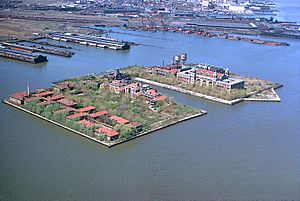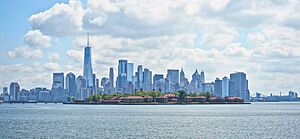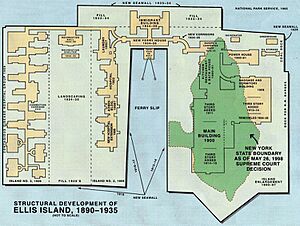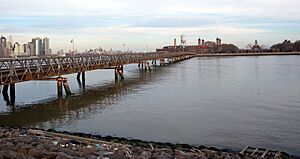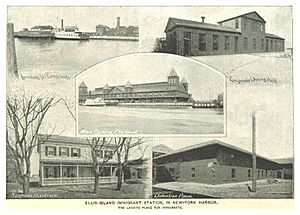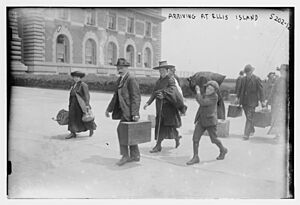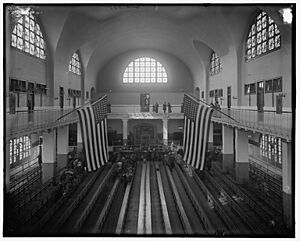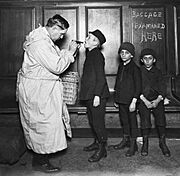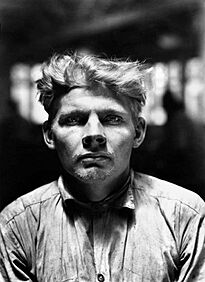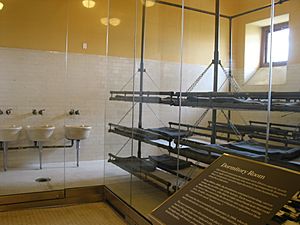Ellis Island facts for kids
Quick facts for kids Ellis Island |
|
|---|---|
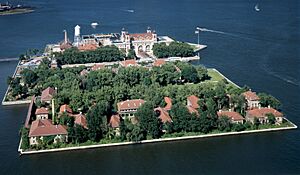
Aerial view of Ellis Island
|
|
| Location | Upper New York Bay Jersey City, New Jersey and New York City United States |
| Area | 27.5 acres (11.1 ha) |
| Elevation | 7 ft (2.1 m) |
| Built | 1900 (main building) 1911 (hospital) |
| Architect | William Alciphron Boring Edward Lippincott Tilton James Knox Taylor |
| Architectural style(s) | Renaissance Revival |
| Governing body | National Park Service |
| Official name: Statue of Liberty National Monument | |
| Designated | May 11, 1965 |
| Official name: Statue of Liberty National Monument, Ellis Island and Liberty Island | |
| Designated | October 15, 1966 |
| Reference no. | 66000058 |
| Official name: Statue of Liberty National Monument, Ellis Island and Liberty Island | |
| Designated | May 27, 1971 |
| Reference no. | 1535 |
| Type | District/Individual interior |
| Designated | November 16, 1993 |
| Reference no. | 1902 (district), 1903 (main building interior) |
| Lua error in Module:Location_map at line 420: attempt to index field 'wikibase' (a nil value). | |
Ellis Island is a famous island in New York Harbor. It sits between the states of New Jersey and New York. This island was once the busiest place for immigrants entering the United States.
From 1892 to 1954, almost 12 million immigrants arrived here. They came through the Port of New York and New Jersey. Today, about 40% of Americans can trace their family history back to these immigrants.
The island is now part of the Statue of Liberty National Monument. It has been since 1965. You can only reach it by ferry. The north side of the island is a national museum about immigration. The south side, which includes the old Ellis Island Immigrant Hospital, offers guided tours.
The island got its name from Samuel Ellis, who bought it in 1774. Before it became an immigration station, it was a military fort called Fort Gibson. It was also a place to store naval supplies.
The first immigration station opened in 1892. Sadly, it burned down in 1897. A new, fireproof station opened in 1900. It had places for medical checks and processing new arrivals. After 1924, Ellis Island mainly held people who were waiting to be allowed into the country or sent back. During World War I and World War II, it also held prisoners of war.
After closing in 1954, the buildings were empty for many years. They were partly reopened in 1976. The main building was fully renovated and became a museum in 1990. The island grew from its original size to 27.5 acres (11.1 ha) through land reclamation. This means new land was added to it.
Contents
Exploring Ellis Island
Ellis Island is located in New York Harbor. It is east of Liberty State Park and north of Liberty Island. Most of the island is in Jersey City, New Jersey. However, a small part is an exclave of New York City.
The island covers about 27.5 acres (11.1 ha). Much of this land was created by adding soil and rock. The original, natural part of the island is about 4.68 acres (1.89 ha) and is in New York. This natural part is on the northern end of the island. The added land is part of New Jersey.
The federal government of the United States has owned the island since 1808. The National Park Service has managed it since 1965.
How the Island Grew
Long ago, the western shore of Upper New York Bay had large mudflats. These areas were rich with oysters, a key food for the Lenape people. Ellis Island was one of three "Oyster Islands." The others were Liberty Island and the now-gone Black Tom Island.
In the late 1800s, the government started making Ellis Island bigger. They added land to build the immigration station. This expansion continued until 1934. The new land came from ship ballast and possibly from digging the New York City Subway. This new land covered the oyster beds and made the shoreline much closer to the other islands.
Today, Ellis Island looks like a "C" shape. It has two main land areas separated by an old ferry pier. The north side, called Island 1, includes the original island. The south side was made from two new islands, Island 2 (created in 1899) and Island 3 (created in 1906).
Sharing the Island: New Jersey and New York
The question of which state owned parts of Ellis Island goes back to the 1600s. Back then, the British took over New Netherland. A land grant said New Jersey owned land "westward of Long Island, and Manhitas Island."
In 1834, New York and New Jersey made an agreement. It set the border in the middle of the Hudson River and New York Harbor. However, New York kept control over the waters and land up to the low-water mark on the New Jersey shore.
New Jersey argued that the new, artificial parts of Ellis Island were in New Jersey. In 1956, after the immigration station closed, the Mayor of Jersey City even tried to claim the island for New Jersey.
The dispute went to the U.S. Supreme Court in 1997. In 1998, the Court decided that most of the island's added land (22.80 acres (9.23 ha)) belongs to New Jersey. The original part of the island (4.68 acres (1.89 ha)) is still part of New York. This decision did not change anything for Liberty Island.
Both states now share control over the land. Neither state is responsible for maintaining the historic buildings.
Visiting Ellis Island
Two ferry docks are on the north side of Ellis Island. There is no fee to enter the Statue of Liberty National Monument. However, you do need to pay for the ferry ride. Statue Cruises has operated the ferry service since 2007. Ferries leave from Liberty State Park in Jersey City and the Battery in Lower Manhattan.
A bridge connects Ellis Island to Liberty State Park. It was built in 1986 for construction supplies and workers. It is not open to the public. There have been ideas to open it as a pedestrian bridge, but these have not happened.
Island History
Early Days and Military Use
Ellis Island was formed by glaciers about 15,000 years ago. The native Mohegan people called it "Kioshk," meaning "Gull Island." This was because many seagulls lived there. The island was mostly marshy and would go underwater at high tide. Native Americans likely used it for hunting and fishing, not for permanent homes.
In 1630, the Dutch bought Kioshk. They called it "Little Oyster Island" because of the many oysters nearby. Later, in 1774, Samuel Ellis bought the island, and it was named after him.
By the 1790s, the U.S. government started building defenses on the island. This was due to possible wars with Britain and France. A fort was built with cannons and barracks. It was named Fort Gibson after the War of 1812. The fort was used as a barracks and a jail for British prisoners.
After the war, Fort Gibson was used less and less. By the 1870s, it became a naval magazine, storing artillery. People worried about the danger of these magazines. In 1881, the guns were removed, and the Navy took full control.
The First Immigration Station (1892-1897)
Before Ellis Island, Castle Clinton in New York City processed immigrants. But the government wanted a new, better station. After some debate, Ellis Island was chosen.
In 1890, the old military buildings were torn down. Construction began on the first federal immigration station. It was a large, two-story wooden building. It also had a hospital, detention center, and laundry. The island's size was doubled to 6 acres (2.4 ha).
The station opened on January 1, 1892. The first immigrant was Annie Moore, a 17-year-old girl from Ireland. In its first year, over 400,000 immigrants passed through. The process included medical checks. About 1% of immigrants were sent back.
The island grew to 14 acres (5.7 ha) by 1896. But on June 15, 1897, a fire destroyed all the wooden buildings. All immigration records from 1855 were lost. Luckily, no one died. In five years, the station had processed 1.5 million immigrants.
The Second Immigration Station (1900-1954)
Building a New Station
After the fire, immigrants were processed at a temporary office. The government quickly planned a new, fireproof station. Architects Edward Lippincott Tilton and William A. Boring won a competition to design it. Their plan included a main building, a kitchen/laundry, a powerhouse, and a hospital. The hospital was built on a new island, Island 2, created south of the main island.
Construction was delayed but finished in 1900. The total cost was $1.5 million. The new station opened on December 17, 1900. On that day, 2,251 immigrants were processed.
Busy Years and Changes
The new station quickly became very busy. More buildings were added, including a hospital expansion and a psychopathic ward. A third island, Island 3, was built for a contagious diseases ward. By 1906, Ellis Island covered 20.25 acres (8.19 ha).
The busiest year was 1907, with over one million immigrants processed. On April 17, 1907, a record 11,747 immigrants arrived in one day.
In 1916, the Black Tom explosion damaged the main building. Its roof collapsed. It was replaced with a beautiful arched ceiling made of Guastavino tiles. During World War I, the station closed temporarily. It was used to hold suspected enemy soldiers and treat wounded American soldiers.
Becoming a Detention Center
After World War I, new laws like the Emergency Quota Act of 1921 greatly reduced immigration. The Immigration Act of 1924 set strict limits. Ellis Island changed from a main processing center to a place for holding immigrants. It held those who had problems with their paperwork or were waiting to be sent back.
The hospital closed in 1930 due to fewer patients. During World War II, Ellis Island was again used by the military. It became a United States Coast Guard base. It held enemy soldiers and immigrants.
By 1947, there were talks of closing Ellis Island because it was too expensive to run. It officially closed on November 12, 1954. The last person to leave was Arne Pettersen, a Norwegian sailor.
Ellis Island Today
After Closing
After 1954, the buildings on Ellis Island were left empty and fell apart. The government tried to sell the island. There were many ideas for its future, like a resort, a college, or a retirement home. But none of these plans worked out.
In 1965, Ellis Island became part of the Statue of Liberty National Monument. President Lyndon B. Johnson approved plans to turn it into a museum and park. However, funding was slow, and the buildings continued to decay.
In the 1970s, the National Park Service began restoring the island. They fixed seawalls and built a new ferry dock. The north side, with the main building, reopened for tours in 1976.
In 1982, a commission led by Lee Iacocca raised money for renovations. The main building and other structures were carefully restored. The goal was to make them look like they did between 1918 and 1924.
The main building opened as a museum on September 10, 1990. It was damaged by Hurricane Sandy in 2012 but reopened a year later. In 2024, a $100 million renovation began to add new exhibits.
Ellis Island National Museum of Immigration
The Ellis Island National Museum of Immigration opened in 1990. It tells the story of American immigration. The museum has exhibits across three floors of the main building. You can see the baggage room, the famous registry room, and old dormitory rooms. There are also theaters for films and performances.
In 2001, the American Family Immigration History Center opened. It helps people research their family's immigration history. In 2015, the museum was renamed the Ellis Island National Museum of Immigration. This was to show that it covers the entire story of immigration to America, not just the years Ellis Island was open.
Wall of Honor
Outside the main building is the Wall of Honor. It lists the names of 775,000 people. These include immigrants, slaves, and Native Americans. People can pay a fee to have a family member's name inscribed on the wall. This money helps support the island's preservation.
The South Side Hospital Buildings
The south side of Ellis Island is home to the old Ellis Island Immigrant Hospital. These buildings are still abandoned and unrenovated. There have been many ideas for what to do with them, but no plans have been carried out.
The organization Save Ellis Island works to preserve these historic hospital buildings. Since 2014, they have offered "Hard Hat Tours" of the south side. The fees from these tours help fund their preservation efforts. The tours also feature art installations by French artist JR.
Immigration Procedures

When Ellis Island closed, almost 12 million immigrants had been processed there. Many of them traveled to other parts of the U.S. from the Central Railroad of New Jersey Terminal nearby.
In the early days, immigrants did not need passports or visas. Shipping companies did initial checks. If someone was denied entry, the company had to pay a fine and cover the cost of sending them back. Most immigrants were allowed in, unless they had certain health issues or other reasons for exclusion.
At first, most immigrants came from Northern and Western Europe. Later, more people arrived from Southern Europe, Eastern Europe, The Middle East, and North Africa. They came seeking new opportunities, escaping hardship, or avoiding persecution.
Immigration peaked between 1905 and 1914, with about one million immigrants each year. After the 1924 Immigration Act, most processing happened overseas. Ellis Island then mainly handled people with paperwork problems or those seeking refuge.
Today, it is estimated that two out of every five Americans are descendants of someone who passed through Ellis Island.
Medical Checks

Before arriving at Ellis Island, steamship companies did some medical checks. More checks and vaccinations happened on the ship. When ships reached New York, those with serious contagious diseases were sent to special quarantine islands.
Most passengers, especially those in steerage (the cheapest class), were taken to Ellis Island for processing. First- and second-class passengers usually did not have to go to Ellis Island.
At Ellis Island, doctors from the United States Public Health Service conducted "line inspections." Immigrants walked in single-file lines. Doctors looked for any visible health problems. They watched how people walked and asked them to drop their bags and walk up stairs.
Doctors used special tools to check for eye diseases like trachoma. If they suspected someone was sick, they would mark their clothes with chalk symbols. For example, 'H' meant heart, 'L' meant lameness, and 'X' meant a suspected mental issue. Those with chalk marks were sent for more detailed checks.
Primary Inspection
After passing medical checks, immigrants went to the Registry Room for primary inspection. Here, U.S. Immigrant Inspectors asked them questions. They wanted to know their name, job, and how much money they had. This helped determine if they could support themselves. Immigrants were usually expected to have between $18 and $25. Some also took literacy tests in their native languages.
Inspectors used other symbols, like 'SI' for Special Inquiry or 'LPC' if someone was "likely to become a public charge" (meaning they might need government help).
Those who passed were given a medical certificate. They often met family and friends at a spot called the "Kissing Post" outside the Registry Room.
Between 1891 and 1930, about 79,000 immigrants were denied entry due to health reasons. About 2% were sent back for other reasons, like being unable to support themselves. Ellis Island was sometimes called the "Island of Tears" for those who were deported.
Holding and Deportation
Ellis Island was used to hold people during World War I. It housed those suspected of being enemy soldiers. After the 1924 Immigration Act, it mainly held immigrants who had problems with their paperwork or were waiting to be deported.
During World War II, it again held German, Italian, and Japanese nationals who were seen as a threat. By 1952, only a few dozen people were held there.
The Name-Change Myth
A popular story says that immigration officials at Ellis Island changed immigrants' names. However, this is not true. Officials used the names written on the ship's passenger lists. They often even corrected mistakes in names. Many immigrants chose to change their names later, after settling into American life. This myth likely comes from how important Ellis Island was as a gateway to America.
Cultural Impact
Honors and Recognition
The Ellis Island Medal of Honor is given each year to American citizens. It honors those who have made great contributions to their communities and country. Past winners include presidents and Nobel Prize winners.
The USPS issued an Ellis Island stamp in 1998.
Historical Status
Ellis Island has been part of the Statue of Liberty National Monument since 1965. It is also listed on the National Register of Historic Places and the New Jersey Register of Historic Places. In 1993, the main building's interior became a New York City designated landmark. The entire island was also named a New York City historic district. In 2017, it was added to UNESCO's list of possible World Heritage Sites.
Images for kids
-
"Reds, anarchists, radicals" waiting to be deported in 1920.
See also
 In Spanish: Isla Ellis para niños
In Spanish: Isla Ellis para niños


